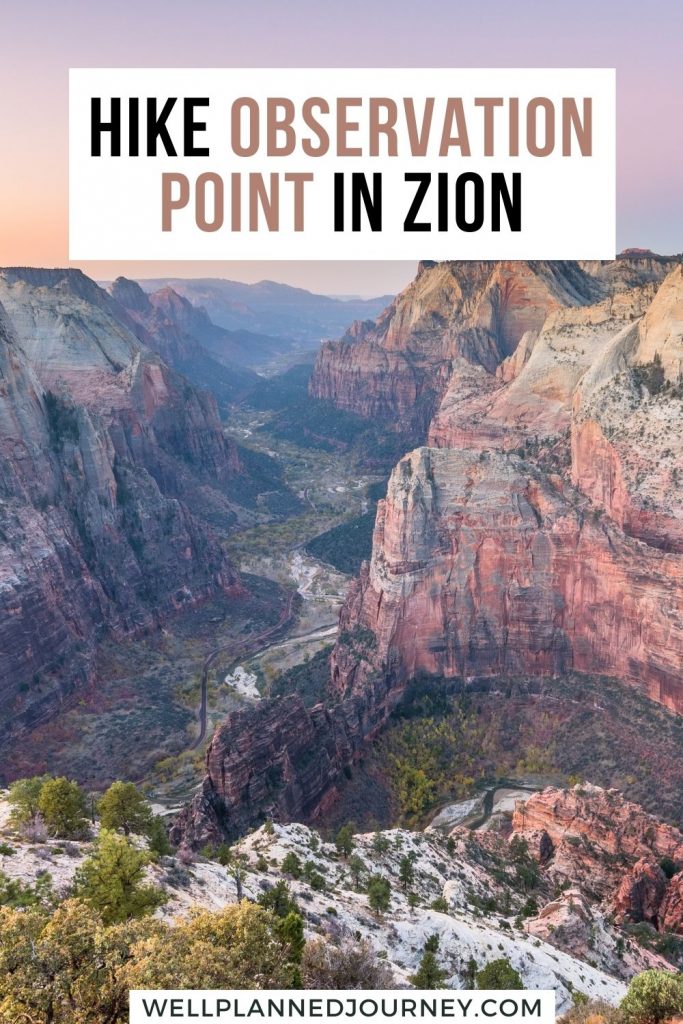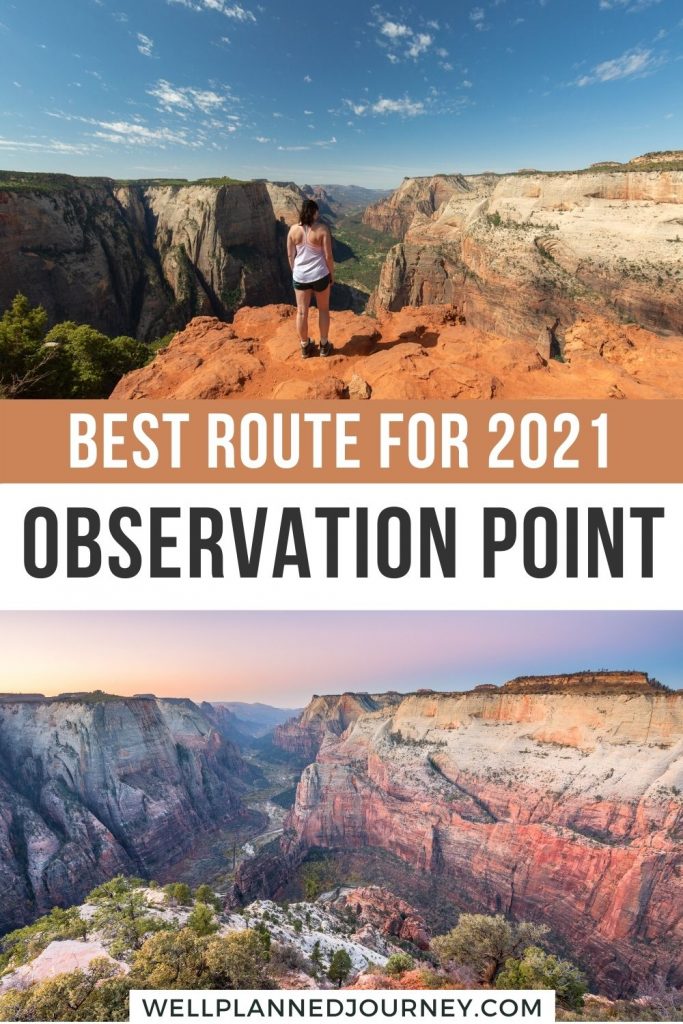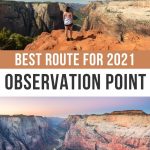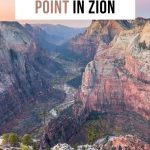Zion National Park is one of the most visited national parks in the country. This Utah national park gets nearly 5 million visitors each year!
But most of those visitors stick to hiking Zion’s claims to fame: The Narrows and Angels Landing. But I’m here to tell you something secret… those aren’t the best hikes in Zion National Park!
Observation Point Zion is the best hike and it is wildly underrated compared to the crowded Narrows and Angels Landing hikes.
From the epic Observation Point summit, you can see all of Zion Canyon, including a view of Angel’s Landing.
Keep reading for the best tips on hiking Observation Point, including how to reach Observation Point from the East Mesa Trail.
This post may contain affiliate links, where I may receive a small commission at no additional cost to you. Read more in this disclosure policy.
Zion National Park At-A-Glance
Before diving in, here are a few highlights to help you plan your trip:
- Best Time to Visit: Spring or Fall are the best times to visit thanks to mild weather, perfect for hiking. Avoid crowds by visiting in March or November, on either end of peak season.
- Where to Stay: If you’re looking to stay in the park, your best option is Zion Lodge. If you’re looking to stay outside the park, I highly recommend either Cliffrose Lodge or Driftwood Lodge in Springdale.
- How to Get There: The closest airports are in Las Vegas (3 hours away) or Salt Lake City (4.5 hours away). Use Expedia to browse flights and find the best price.
- How to Get Around: Zion National Park requires visitors to take the free shuttle from Spring to Fall. However, you’ll still need your own car to get to Zion. Use Expedia to browse deals on rental cars or rent an RV or campervan with Outdoorsy!
- Best Self-Guided Tour: My favorite way to learn more about the park is with GyPSy Guides, a narrated self-guided tour perfect for road trips and scenic drives. The Zion & Bryce Canyon Guide and the Utah “Mighty 5” Bundle both provide incredible commentary and detail about the history and geology of these parks.
- Don’t Forget: Be sure to get an America the Beautiful National Park Pass ahead of time. This $80 pass is valid for 12 months and get you into all 400+ national park sites (including Zion!).
Best Time to Hike Zion Observation Point
While Zion National Park is open year-round, the best time to go to Zion National Park is in the Spring or Fall.
Winter comes with a chance of snow and ice storms, making the Observation Point trail difficult to navigate. Summer crowds and temperatures make the park less enjoyable.
For the best experience (and fewer crowds on the trail!) visit Zion National Park from April-May or September-October.
Zion is also a popular part of any Utah road trip. Visiting in late Spring or early Fall is also a great time for other nearby national parks, like Bryce Canyon, Capitol Reef, Arches, and Canyonlands.
Read More: The Best Time to Visit Zion
Where to Stay Near Observation Point Zion National Park
This interactive map can also help you search all the available hotels and rental properties near Zion National Park! Simply scroll and click the map below to see what is available!
Zion National Park is unique in that it has a decent size town just outside its boundaries. Springdale offers tons of accommodation options. Cliffrose Lodge is perfect for those seeking luxury and the Driftwood Lodge is a budget-friendly option.
Book a stay at the coveted Zion Lodge for a unique in-park stay. The Zion Lodge has both cabins and traditional hotel rooms.
Like most national park lodges, you’ll need to book your stay at Zion Lodge 13 months in advance when reservations open.
Want to stay in the park but can’t find a spot at the Zion Lodge? Book a few nights at the South Campground or Watchman Campground. Both offer restrooms and drinking water.
You can book a site at Watchman Campground 6 months out, but South Campground is only reservable 2 weeks in advance.
Getting to the Observation Point Trail Zion
Zion National Park is 3 hours from Las Vegas and 4 hours from Salt Lake City, both of which are home to major airports.
From the main interstate, I-15, you’ll follow the scenic Highway 9 from St. George to Zion National Park. Springdale sits right at the edge of Zion National Park, boasting many spots to eat, drink, and rent gear!
Zion National Park requires visitors to take the park’s free shuttle within the park. The shuttle reduces congestion in the park and stops at all major trailheads.
But the Zion shuttle can get incredibly crowded. To beat the crowds and heat when hiking Observation Point, take the first shuttle of the day, departing from the Visitor Center around 6 am.
While Springdale runs a shuttle to the Zion Visitor Center, it does not start running until 7am. To get an early start, you’re best off driving and parking at the visitor center to board the early shuttle into the park.
For more on where to stay, when to visit, and getting around, read the Ultimate Guide to Zion National Park.
Zion Observation Point Trail Details
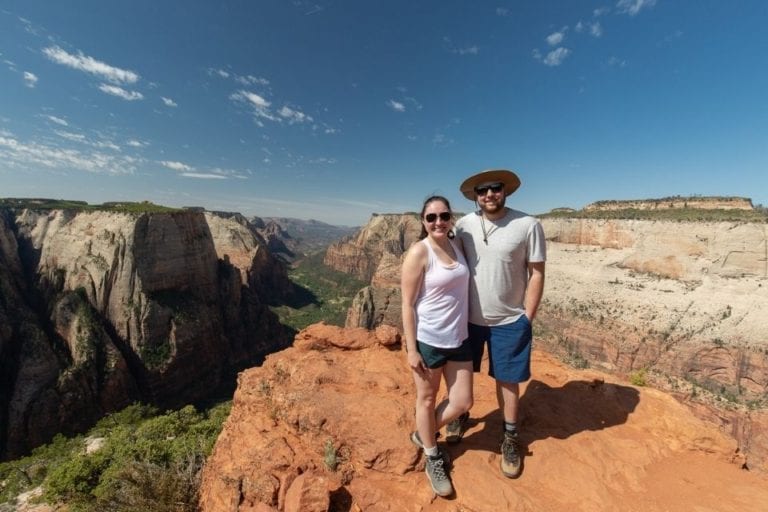
- Distance: 7.1 miles
- Elevation Gain: 2,788 feet
- Difficulty: Hard
- Estimated Hike Time: 5 hours
- Trailhead: Weeping Rock
- Trailhead Facilities: Pit toilets, shuttle stop
Observation Point in Zion National Park is not for the faint of heart. This trail is a less intimidating version of Angels Landing, but there are still some serious drop-offs.
The 2,200-foot climb to the summit is difficult even for experienced hikers.
Take the Zion park shuttle to the Weeping Rock trailhead. The climb up to Observation Point begins shortly after the trailhead and is mostly exposed. Start your hike early to avoid afternoon heat!
Important Note
The trail to Observation Point from Weeping Rock is currently closed after a major rockfall in 2019. Observation Point can still be reached from the East Mesa Trail (more information on that below). While the Weeping Rock trailhead is closed, this guide is still a great tool for planning a future trip to Zion National Park.
Hiking Observation Point Zion
The trail to Observation Point starts along the Zion Canyon Scenic Drive and shares the trail with the path to Weeping Rock. After a few hundred feet, the trail splits.
To reach Weeping Rock, go left. Continue on to climb to Observation Point. Weeping Rock is a great way to finish your Observation Point hike, so save it for the end!
Just after the trail split, the quick elevation gain begins. A series of switchbacks lifts you off the canyon floor. The switchbacks climb 1,000 feet over 1.5 miles, roughly a 12% grade.
Hidden Canyon
About halfway through the switchbacks, you’ll reach a split in the trail. Continue left to Observation Point or right to explore Hidden Canyon.
This side trip is perfect for those who want to scramble along a rocky canyon, but want to avoid the crowds of Angels Landing.
While the trail to Hidden Canyon only adds 2.5 miles and 200 feet of elevation, I recommend saving it for your trip back down from Observation Point. Conserve your energy to make it to this epic viewpoint first!
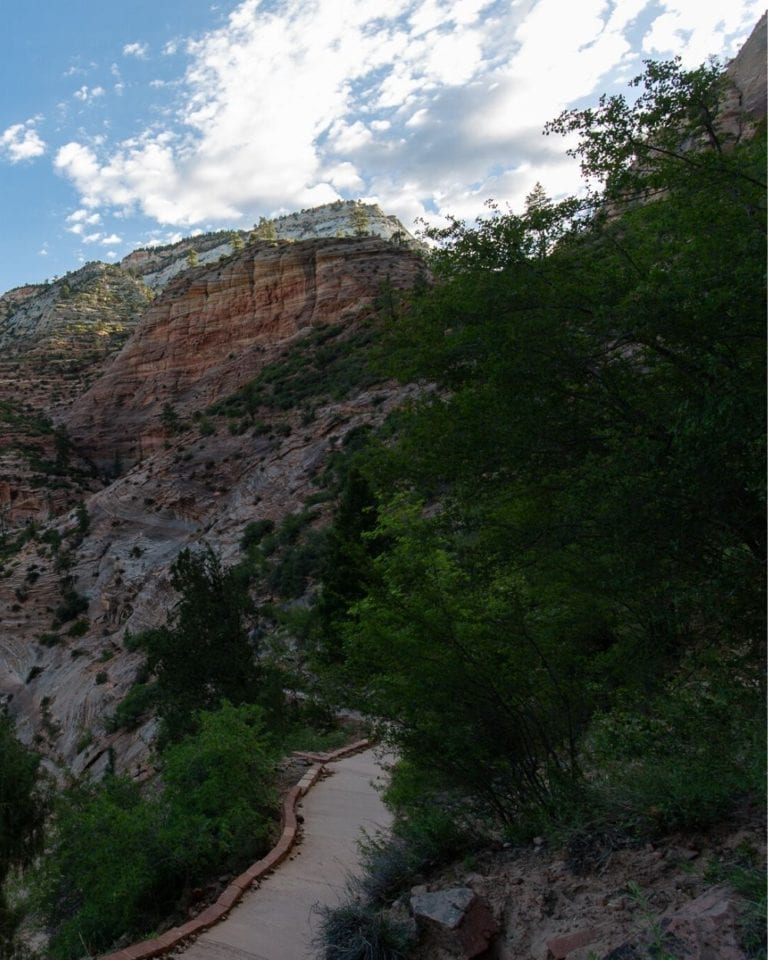
Echo Canyon
After reaching the top of the switchbacks, you’ll be greeted with a change of scenery. Leaving behind the exposed dirt climb, you’ll enter a cool, refreshing slot canyon.
Echo Canyon is wide by slot canyon standards and provides plenty of shade and protection from heat. This is the perfect spot for a water or snack break.
East Rim Trail Junction
After leaving the cool protection of Echo Canyon, you’ll return to the dry, exposed climb up the side of Zion Canyon. The trail from the Weeping Rock trailhead joins the East Rim Trail not long after.
After the trails join, both climb up to Observation Point on a final series of switchbacks. You’ll cover another 1,000 feet in just under a mile.
If you’re afraid of heights, don’t look down! The trail follows the canyon wall and you’re over 2,000 feet above the trailhead now. Honestly, I’m terrified of heights and the sight of the tiny Zion Canyon Scenic Drive below was a bit much.
Thankfully, the trail is fairly wide here, so for anyone with a fear of heights, stay along the canyon wall and power through.
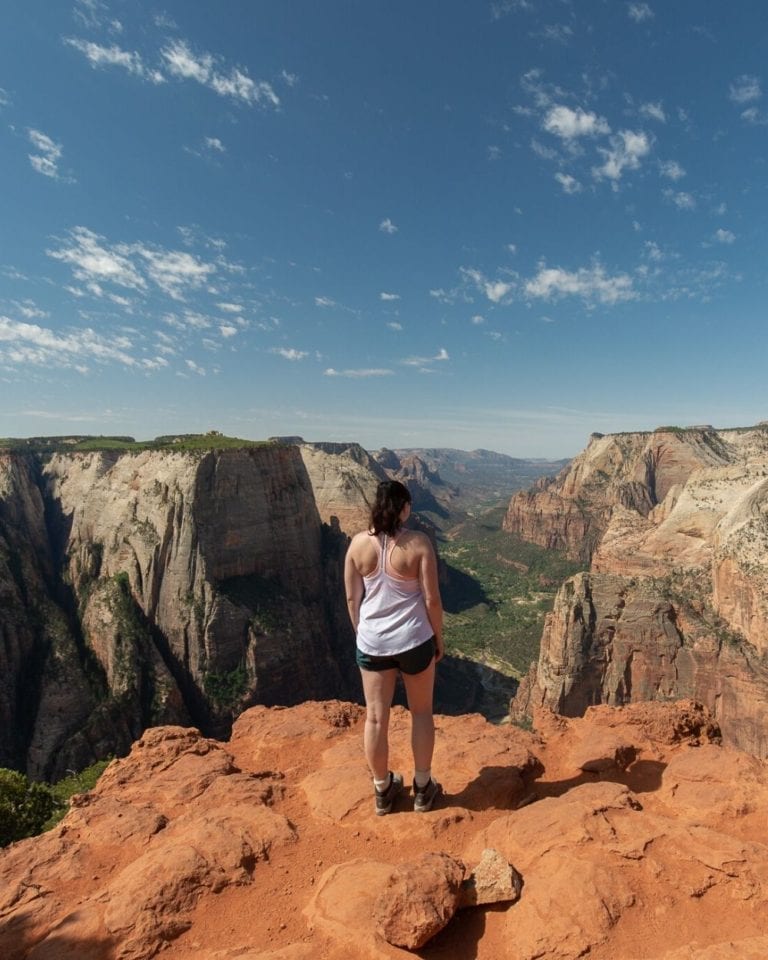
The Epic View from Zion National Park Observation Point
After climbing the final switchbacks, the trail flattens out (and heads away from the cliff edge). Follow the flat trail through the brush around the top of the canyon and out to Observation Point.
The hike is long and strenuous, but you made it! The view from Observation Point is absolutely the best in the park and the reason this is one of the top hikes in Zion.
From Observation Point, you can see the entirety of Zion Canyon, including tiny little Angels Landing 1,000 feet below. See if you can spot the ant-like Zion shuttle on the scenic road carving its way through the canyon.
After snapping some essential pictures, take a break and soak in the views at Observation Point. You’ve earned it!
Before heading back down, be sure to collect all trash to pack out.
Don’t miss the best of Utah’s national parks on your upcoming trip! This free, printable Utah national park road trip itinerary covers all the best points of interest in all 5 Utah parks, plus bonus tips on where to stay and side trips to nearby state parks and monuments.
Download your free Utah road trip itinerary here.
Alternate Route: Hiking Observation Point on the East Mesa Trail Zion
- Distance: 6.7 miles
- Elevation Gain: 695 feet
- Difficulty: Moderate
- Estimated Hike Time: 3 hours
- Trailhead: East Mesa
Due to a large rockfall in 2019, the route to Observation Point from Weeping Rock is closed until further notice.
But good news: Observation Point can still be reached from the East Mesa Trailhead! And more good news: the trail is actually easier!
Start at the East Mesa Trailhead on the very eastern edge of Zion National Park.
To get to the East Mesa Trailhead, follow Highway 9, also called the scenic Zion-Mt. Carmel Highway, past Checkerboard Mesa, and turn left on North Fork County Road. You’ll pass the popular Zion Ponderosa Ranch Resort as you follow back roads to the trailhead.
The road to the East Mesa Trailhead is rough and unpaved and not recommended for those without 4WD.
If you don’t have a 4WD vehicle, you can park further away from the trailhead in a dirt lot before East Mesa Road gets worse and walk the last half mile or so. Or, you can opt for the Observation Point Shuttle by East Zion Adventures.
If this doesn’t sound appealing to you, consider hiking Angels Landing instead.
Important Note
Zion National Park is requiring all visitors to get an advance permit to hike Angels Landing. You can read more about how to get an Angels Landing permit here.
The East Mesa Trail has minimal elevation change until descending 400 feet to meet the trail to Observation Point. After the descent, you’re only a quarter-mile from Observation Point and the best view in Zion National Park!
While hiking Observation Point from the East Mesa Trail isn’t as spectacular as the journey up from Weeping Rock, the end view is still the same.
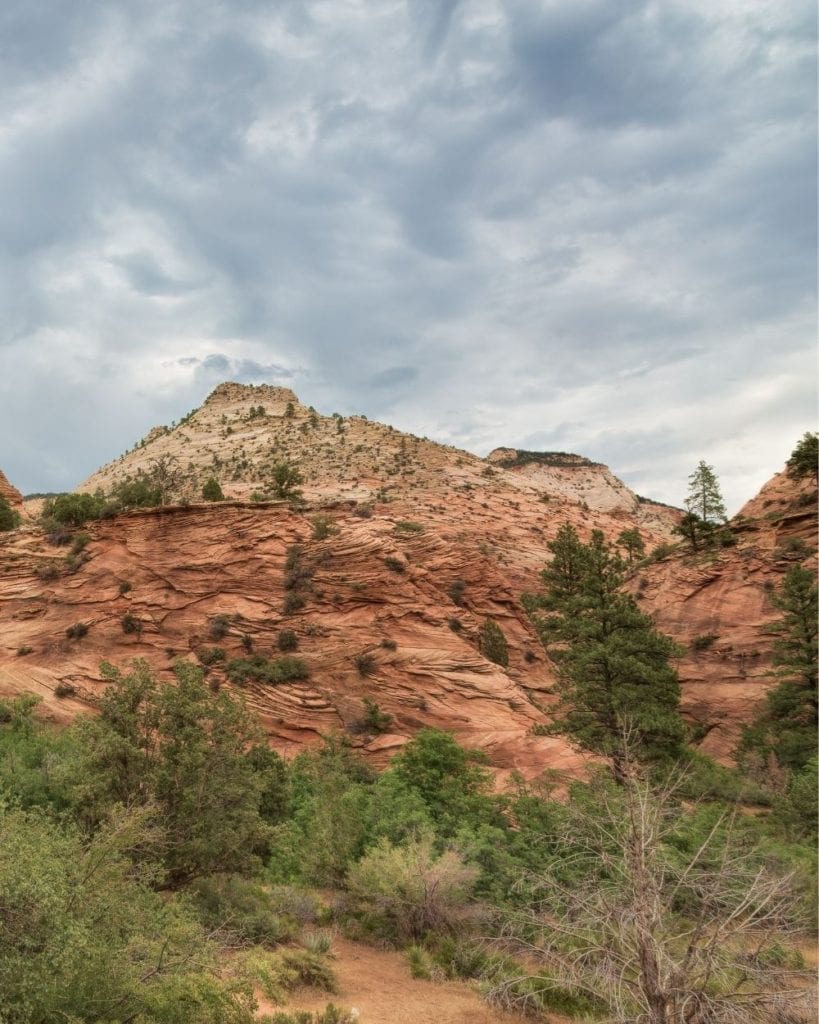
Observation Point Zion Trail Map
Maps are an ever-important part of planning a hike. Check out this map of the Observation Point hike from both the Weeping Rock Trailhead and East Mesa Trailhead.
See the Observation Point map here.
Tips for the Observation Point Zion Hike
Observation Point is the best hike in Zion National Park. To ensure the best experience, here are a few helpful tips:
- Take the first shuttle of the day into the park. The line for Zion’s shuttle is long in the afternoons. Some visitors have to wait over an hour to get into the park. Start your day early by taking the first shuttle of the day, around 6 am, into the park. You’ll beat the heat on your hike too!
- Make the side trips to Weeping Rock and Hidden Canyon. Three trails start from the same trailhead: Observation Point, Weeping Rock, and Hidden Canyon. Make a full day out of the hike to Observation Point by adding on Weeping Rock and Hidden Canyon! But save these hikes for your journey back down from Observation Point – you’ll want to save your energy to get to the peak first!
- Take frequent breaks. This is a strenuous trail, even for experienced hikers. Break up the hike by taking frequent breaks. The best spots to relax on the trail are in Echo Canyon (a brief escape from the sun) and at the top of Observation Point (amazing views + snacks, it can’t get better than that!).
- Follow the Leave No Trace Principles. Stay on the trail, keep your distance from wildlife, and respect other hikers. Remember that trail etiquette gives uphill hikers the right-of-way. Want to learn more about the Leave No Trace Principles and trail etiquette? Read my guide on Hiking for Beginners.
- Check with park rangers for the latest conditions. Park rangers can fill you in on the latest closures and the conditions of the road out to East Mesa Trailhead. This can help you make an informed decision on whether you want to attempt the drive
Are you visiting multiple national parks in the next year? The America the Beautiful National Park Pass gets you into 400+ national park sites, including all 63 national parks, for 12 months!
Get your national park pass ahead of time for only $80.
What to Pack for the Observation Point Hike Zion
Every hiker should be prepared, particularly in hot, dry environments like Zion National Park. Before starting your hike to Observation Point, make sure you have all these hiking essentials packed:
- The Ten Essentials. This includes must-have safety gear, like an emergency shelter if you were to face an unexpected night in the wilderness. Don’t forget a first aid kit! For more on the 10 essentials, check out my Ultimate Hiking Gear Guide.
- Plenty of water. Experts recommend that you carry at least 0.5 L of water per 1 hour of hiking. In hot, dry environments like Zion National Park, you should double the amount of water you carry. For the hike to Observation Point, plan on carrying 3 to 5 liters (100 to 170 ounces) of water. A water reservoir will reduce the weight of carrying large amounts of water on long hikes. The Osprey Hydraulics Reservoir is my go-to water reservoir and fits well in most hiking backpacks.
- Hiking shoes with good traction. Whether you prefer lightweight trail running shoes or sturdy hiking boots, break your shoes in first and ensure they have good grip. I don’t recommend hiking this trail in sneakers as the rock surfaces can be slippery. My favorite shoes for hiking in Zion are the Columbia Newton Ridge boots or the Altra Lone Peak Trail Runners.
- Sunscreen and Sun Hat. Much of the Observation Point trail is unshaded. Protect yourself from the sun by wearing and reapplying sunscreen and keeping your head covered with a sun hat or baseball cap.
- Lightweight Hiking Poles. Hiking, or trekking, poles can help reduce the impact of strenuous up or downhill hikes, particularly for those with knee problems. For lightweight, collapsible poles, I highly recommend REI’s Flash Carbon trekking poles.
Looking for more tips on what to pack for your trip? Check out my guides on the best hiking gear, what to pack for a road trip, and essential camping gear for all my favorite gear picks and tips to make packing for your trip a breeze!
Frequently Asked Questions About Observation Point
When will Observation Point reopen?
After a large rockfall in 2019, the trail to Observation Point from Weeping Rock is closed indefinitely. But hikers can still reach Observation Point from the East Mesa Trail, an easier, shorter trail starting on the east side of Zion National Park. Always check the Zion National Park Service website for the latest updates on trail status.
Can you drive to Zion Observation Point?
Observation Point can only be reached on foot. The two main trails to Observation Point are from the Weeping Rock Trailhead and the East Mesa Trailhead. To hike Observation Point from the Weeping Rock Trailhead, park at the visitor center and take the free shuttle to the trailhead. To hike Observation Point from the East Mesa Trailhead, take the Zion-Mt. Carmel Scenic Highway to reach the east side of the park.
How long does it take to hike Observation Point Zion?
Hiking Observation Point takes roughly half a day. If you are hiking Observation Point from the Weeping Rock trailhead, the hike is roughly 5 hours. The hike from the East Mesa Trailhead is only 3 hours. Always budget more time than you think you need, particularly for strenuous hikes.
How difficult is Observation Point Zion?
The Observation Point hike is strenuous. The 7.1-mile trail has roughly 2,800 feet of elevation gain. That is an average 15% grade for the ascent to Observation Point. While this hike is strenuous, even less experienced hikers can complete the hike with plenty of water and breaks.
Can you see Angels Landing from Observation Point?
The Observation Point hike is strenuous. The 7.1-mile trail has roughly 2,800 feet of elevation gain. That is an average 15% grade for the ascent to Observation Point. While this hike is strenuous, even less experienced hikers can complete the hike with plenty of water and breaks.
Final Thoughts on Hiking Observation Point
Observation Point belongs at the top of your Zion National Park bucket list (more so than Angels Landing in my opinion!). Be prepared for your hike by checking trail status for closures and packing plenty of water.
Planning a trip to Zion National Park? You’ll want to read these posts too!
- When to Go: The Best Time to Visit Zion National Park
- Best Tips: Ultimate Guide to Zion National Park
- Add Bryce: 3-Day Road Trip from Zion to Bryce Canyon
- Add Grand Canyon: 10-Day Grand Canyon and Zion Road Trip
- Road Trip: Ultimate 8-Day Utah Road Trip Itinerary
- All Utah Parks: 14 Best National Parks in Utah
Don’t miss the best of Utah’s national parks on your upcoming trip! This free, printable Utah national park road trip itinerary covers all the best points of interest in all 5 Utah parks, plus bonus tips on where to stay and side trips to nearby state parks and monuments.
Download your free Utah road trip itinerary here.
Don’t Forget to Save This Post on Pinterest
